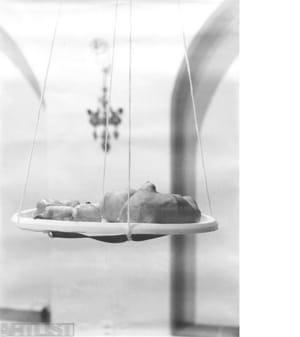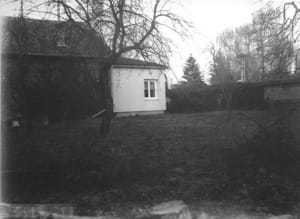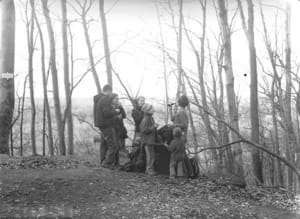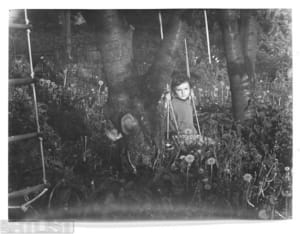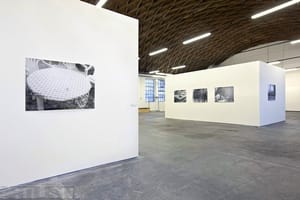- First Name
- Michal
- Surname
- Kalhous
- Born
- 1967
- Birth place
- Valašské Meziříčí
- Place of work
- Šternberk
- i-datum
- ↳ Find in the VVP AVU database
- Keywords
- CSU Library
- ↳ Find in the catalogue
About artist
Michal Kalhous is the author of those large, grey and sloppily focused photographs on which we can see an excavator, pilgrims at a crucifix or a sausage on a string. The world is filled with billions of objects and by combining them we can reach a much higher number; and if you, God forbid, start to photograph them, then there are new realities created that need to be put into context and we just continue to hope that this chaos may eventually make sense. And I don’t dare speak about situations, of which there will certainly be infinity.
If we exhibit these types of photographs – similarly to Michal Kalhous – in a gallery, then we expect for them to be meaningful in some way. We look at them and ponder their meaning. Or this whole messy situation can be resolved just by looking, without pondering why and how, and by letting ourselves be carried away and letting the time just float by, and we can leave the confusion on the shoulders of others. Unfortunately, we are all pulled into our time, culture and things we use, and into education that has formed us. The path of looking at reality without bias is increasingly limited.
Therefore, also Michal Kalhous, whom I consider to be one of the few contemporary liberators of our predetermined perception and experiencing, reacts, in his photographic work, to realities that he is tied to. One of the first things in his publicised work was his relationship to expressionism, to death and critical situations, to the boundaries of the body and borders of things; prevailing was also a fascination over movement, and over chaotic situations in our lives. In the most recent years, perhaps under the influence of his increasingly intensive family life, he has focused on redefining human society on Christian foundations. Family should be like an orchard, human society is more than individuality, we must help the weak, the world is full of small miracles – you just need to see them. It seems like he is trying to work his way through to the at least a little liberal, unbiased child’s perception.
What is most viable on Michal Kalhous’ photographs is precisely that contradiction between their satiation of cultural meanings and the manner of overlooking such meanings or reacting to them with hope and amazement.
- Author of the annotation
- Jan Freiberg
- Published
- 2012
CV
Studies:
1990-1995 Faculty of Philosophy, University Palacký, Olomouc
1985-1990 Faculty of Natural Sciences, University Palacký, Olomouc
Employment:
since 2010 head of the Department of Creative Photography
since 2009 Head of the Department of Intermedia
since 2006 works as associate professor at the Faculty of Arts, Ostrava University
2001-2006 works as curator, Galerie Šternberk
Exhibitions
- Solo exhibitions
-
2014
Muž a žena, Plato Ostrava, 11.09.2014 – 30.11.2014
2013
My my father is a star
2012
Dobrý den pane sousede, Galerie Caesar
Dobrý den, pane sousede, Focus café Ústí nad Labem
2011
Z Rýč, míč, klíč, Fotofestival Uničov, Uničov
Rýč, míč, klíč, Galerie E. Filly, Ústí nad Labem
2009
Zahrada, Galerie Půda Jihlava
Šálek s víčkem, Studio Fotograf, Praha (Prague)
2006
"36", 36, Olomouc (s Martin Horák)
Hra na harfu to není, A.M.180, Praha
Zemní práce, Sokolská 26, Ostrava
2005
Kladky, Ateliér Josefa Sudka, Praha (Prague)
Nemaluju, Moravská galerie, Brno
Galerie Jiřího Jílka, Šumperk
2004
Fotografická galerie Fiducia, Ostrava
Dům umění České Budějovice
Galerie E. Filly, Ústí nad Labem
2003
Divadlo hudby, Olomouc
2002
Galerie V. Špály, Praha (Prague)
2000
Galerie 761, Ostrava
Galerie U rudého vola, Brno
1999
Galerie MXM, Praha (Prague)
1997
Galerie Velryba, Praha (Prague)
1996
Galerie Metro 70, Prostějov
Minikinokavárna, Ostrava
Galerie Fiducia, Ostrava
1995
Divadlo hudby, Olomouc
- Group exhibitions not included in ARTLIST.
-
2014
VII. Nový zlínský salon 2014, 14. května – 31. srpna 2014Ze středu ven. Umění regionů 1985 – 2010 / Západočeská galerie v Plzni / Plzeň / 2. 4. – 8. 6. 2014 ZE STŘEDU VEN – UMĚNÍ REGIONŮ 1985–2010 Západočeská galerie v Plzni, výstavní síň Masné krámy, Pražská 18, Plzeň 2. 4. – 8. 6. 2014 O židli / 9th International Biennial of Photography and Visual Arts / Liège / 15. 3. – 25. 5. 2014 O židli 15. 3. – 25. 5. 2014 Česká sekce Bienále fotografie a vizuálního umění 20142013Začátek století: České umění prvního desetiletí 21. Století, Dům umění OstravaPavel Baňka: Jejich fotografie, Galerie 1. patro, Praha (Prague)
2012-2013
Od Tiziana po Warhola: Muzeum umění Olomouc 1951-2011 (IV. Výtvarné umění 1948-2011), Trojlodí, Olomouc
2012
Začátek století / The Beginning of the Century, Dům umění, Ostrava
Začátek století / The Beginning of the Century, Výstavní síň Masné krámy, Plzeň (Pilsen)
2011
Ztišeno, Wannieck Gallery, Brno
Mutující médium, Rudolfinum, Praha
Sad, Fotofestival Uničov, Uničov
2010 Altruismus. Kunst aus tschechien heute, des Kooperationsprojektes der Kunstvereine Düsseldorf – Köln – Bonn, DE
2009
Art in general, Bílý papír černá nevěsta. Současná scéna v České republice, Prague bienale 4, Praha
2007
OVA 95–05, Galerie výtvarného umění Ostrava
Ropovod, Galerie Emila Filly, Ústí nad Labem
Kurátorský experiment II – Země snivců, Výstavní prostor na chodbě, PdF UJEP,Ústí nad Labem
I don't wanna talk, Centralnyj vystavnyj zal / Bolšaja manež, Moskva, RUS
Sklerotická) soused[ka] / (Sklerotische) nachbar[i]n. Contemporary photography and video from Czech Republic, Schloss Wolkersdorf, AUS
Kurátorský experiment II – Země snivců, FaVU, Brno
2006
I don´t wanna talk, Petrozavodsk, RUS
Land locked (New photography and video from the Czech republic), Well Gallery, London College of Communication, Londýn, UK
2005
Fotografie ... ??, DpzK, Brno
2004
Fotografie ... ??, Galerie Klatovy/Klenová, Klatovy
2003
Wunderland, Hornické muzeum Landek, Ostrava
Čeští autsajdři, Dům slezské kultury, Katovice, PL
Wunderland, Muzeum těžby, Kiruna, SE
2002
Cheb
Čeští autsajdři,Galeria Arsenal, Bialystok, PL
IV. Bienále mladého umění Zvon, GHMP, Dům U Kamenného zvonu
ICING, Galerie V. Špály, Praha
2001
Kolmo k ose II., Dům umění, Opava
ICING, Dunajvarosz, HU
Galerie V. Löffevra, Košice, SK
2000
Vidiny, NoD, Praha
Pocta Důl Michal, Důl Michal, Ostrava
1999
Animal Art – Práce pro místo, Galerie Sýpka, Vlkov u Brna
Akční Praha, Roxy, Praha
NoD, Praha
Ostrava v Ústí, Ústí nad Labem
II. Nový zlínský salon, KGVU, Dům umění, Zlín
1998
Ostrava umjeni...?,Dům umění, Ostrava
Ostrava umjeni...?, Mánes, Praha
1997
Snížený rozpočet, Mánes, Praha
I. Zlínský salon mladých, KGVU, Dům umění, Zlín
1995
Zkušební provoz, Mánes, Praha
- Collections
- Muzeum umění Olomouc Galerie Klatovy - KlenováMoravská galerie v Brně
- Other realisations
Recovery of the plaque to writer, translator and founder of the Communist Youth in Šternberk Vinc Schwarz.
Recovery of Czech citizenship displaced Sudeten Germans Erica Pedretti, currently Swiss writer.
Photos instead of ads, First exhibition in the public transport. Sponsorship of the Soros Center for Contemporary Art Prague.
Entering and production of the foundation stone of Ostrava Kunsthalle, but for the money of Jiří Surůvka, who is the owner of the stone.
Monography
- Articles
Články, recenze:
- Eva Kulová, Michal Kalhous - Zahrada, Ateliér 10/2009, s. 14
- Eva Kulová, Michal Kalhous, Fotograf 13/2009, s. 48-57
- Terezie Nekvindová, Galerie Šternberk, in. Ateliér 25-26/ 2007, s. 11
- Vendula Fremlová, Martin Kolář, Kurátorský Experiment II – Země snivců, in. Ateliér 14 – 15 / 2007 s. 5
- Gabriela Gabrová, Jsem pomalý fotograf, in. Olomoucký den 23. 4. 2007, s. 7
- Terezie Nekvindová, Musím říct, že to byly chvíle, kdy jsem se cítil jakž takž dobře. Rozhovor s Michalem Kalhousem, in: Terezie Nekvindová - Martin Fišr (eds.), Galerie Šternberk 2006, Šternberk 2006, s. 5-10
- Martin Mikolášek, OVA 95–05, in. A2 41/2006
- Petr Borkovec, Ale nikdo tu nemaluje, in. A2 4/2005
- Pavel Vančát, Fotograf Kalhous dělá, co ho baví, in. Hospodářské noviny 20. 5. 2005
- Miroslav Koval, Není nic, in. Revolver revue, in. 60/2005, s. 72-81
- Fotografie Michala Kalhouse, in. Psí víno 32/2005
- Pavel Vančát, Inteligentní fotografie, in. Umělec 2/2004, s. 88-89
